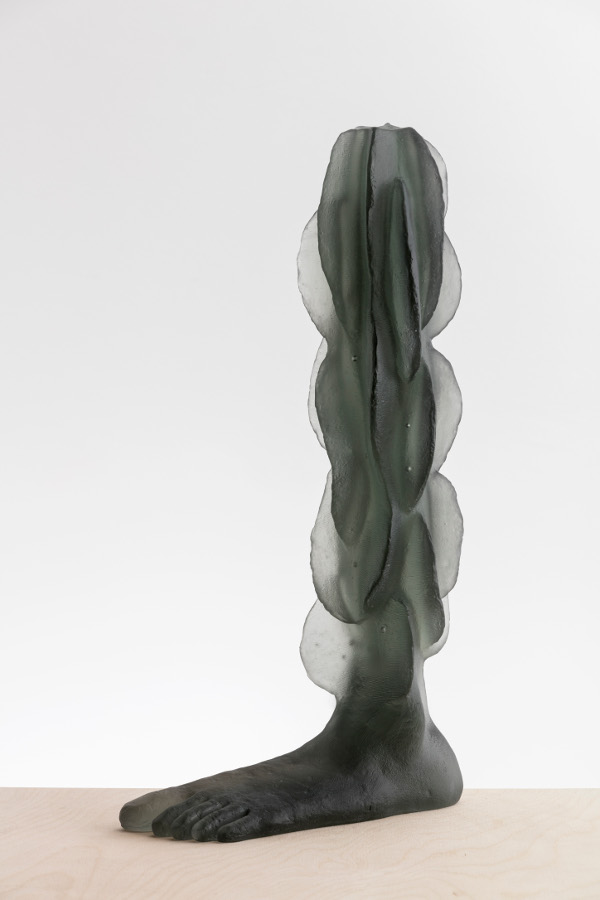Bødker – MARIA LUND
75003 Paris, Tel. (+33) 01 42 76 00 33
What follows – Ce qui suit
/
OPENING: Thursday April 27th from 6pm to 9 pm with Lene Bødker present.
READING: Tuesday May 23rd at 8pm, writer Belinda Cannone will read excerpts from her essay « S’émerveiller » (« Marveling ») that just got published by Editions Stock.
/
Then the eyes of both were opened, and they knew that they were naked.
And they sewed fig leaves together and made themselves loincloths.
Genesis 3: 7
/
/
The biblical sense of the term knowledge evokes the intimate experience of a mystery. A definition that differs completely from the one inherited from the Age of Enlightenment, which possesses a rational and empirical dimension. Thus, there is a form of paradox that emerges here for Western Judeo-Christian societies, between the desire for enlightenment, and the forbidden, choice and fault. Lene Bødker’s most recent work draws its inspiration from the story of The Fall, from the fundamentals that come from it and by which our contemporary societies are still deeply influenced. Far from a simple illustration of the story, the artist takes isolated elements and thematics which she treats as sculpture in order to give them the archetypal, metaphorical dimension that caracterizes her work. The human body is introduced explicitely next to the more abstract geometric and organic shapes, that used to prevail in her universe until now. A different nerve and a newly found fragility can be felt in these sculptures, which mark a turning point in her work.
/
T R E M B L I N G A N D T R A N Q U I L I T Y
The Fall establishes disquiet in the human being – doubt, desire, guilt and fear. Without explicitly naming them, Lene Bødker refers to these notions in works such as I’m still alive and You’re still alive, with tree trunks in a state between growth and torsos with pruned branches. At home and embraced suggests security and love found at home in the shape of reliefs made of molding and floral and geometric ornaments from ancient frames. The art of framing becomes a symbol for refinement and a loving and peaceful shelter.
/
N A T U R E H U M A N B E I N G - A L W A Y S
In Foot on the ground, the idea of Man as part of Nature, his anchoring and affiliation to it is evoked with a foot solidly planted, of which the extension is not a leg but a growth reminiscent of a cactus. Nursing and Gaia – two “infinite columns” made of symmetrically superimposed breasts – deals with the connection between the woman, a temptress with pointed breasts, the mystery of creation and its wondrous and constraining dimension as well as the inscribing of this reality in a never-ending repetition. References to art history – from archaic fertility goddesses to Brancusi – are obvious and widen the scope of the works.
The Morphosis series – three dense and dynamic tree trunks in muted and earthy colors penetrated and awoken by light – convey the advent of a shape and its evolution. The emerging or mutant shape is also explored in Could we be friends – a touching and hybrid “body” that creates numerous associations. Trust shows an open hand simultaneously suggesting availability, power and fragility. Is it the hand that offers the forbidden fruit? Maybe. In You did it, the snake is introduced in the shape of a “rising” spiral made of wide open interlacing from which light radiates. All the ambiguity of the mythical reptile – both tempter and key to forbidden yet attractive knowledge – is thus suggested.
/
D O U B L E N A T U R E
Well, a large container which surface is rhythmed by floral inspired elements seems to situate itself between nature and culture; its double affiliation is underlined by color, which, because of light variations, goes from Antique pink to light green. Water is a recurrent theme in the work of Lene Bødker, who likes to describe and bring life to that element. It can be seen as a symbol of renewal, transition from a state to another, metamorphosis as it can also recall Nature’s movement and rhythm (Waves).
Glass gives shape, it gives physical life. Through its capacity to carry light, it makes a connection between the material and immaterial – between the tangible and the spiritual. The dominating duality of the Western world, that is the long lasting “rule” of the separation of body and soul, finds a common ground here.
Glass is “dangerously” beautiful and partly out of our grasp because of its fluctuant aspect and its constant interaction with the environment. It seizes and unsettles us, in the same way as we often find ourselves in front of contradictions that we carry.
/
b a c k g r o u n d
Lene Bødker (born in Denmark in 1958) is not unknown to the French public, as the Galerie Maria Lund has welcomed four exhibitions of her work since 2003. During the summer of 2016, the Maison Louis Carré (Bazoches-sur-Guyonne) dedicated a solo show to the artist. Her works are featured in numerous collections such as the V&A, London; Musée des Arts Décoratifs, Paris; Musée-atelier du verre, Sars-Poteries ; Glasmuseum Hentrich – Museum Kunst Palast, Düsseldorf ; Designcenter Ishigawa, Kanazawa, Glasmuseum Alter Hof Herding, Coesfeld-Lette ; Glasmuseet Ebeltoft and the Danish Arts Foundation, Denmark. In 1994, Lene Bødker’s work was the recipient of the Yutta Cuny-Franz Foundation, Honourable Award ; and in 2007 she received the Grand Prize, Kanazawa Glass Award. Since 2012, she has been one of the rare Danish artists to be awarded a lifelong grant by the Danish Arts Foundation.
